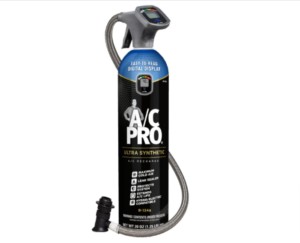Recharging your car’s AC system yourself is now possible, thanks to readily available kits. This guide provides a step-by-step approach on How To Recharge Air Conditioner in your car.
What You’ll Need to Recharge Your Car AC
Before you begin, gather the following:
- AC Recharge Kit: Choose a kit with the correct refrigerant for your car (R-134a or R-1234yf).
- Safety Gear: Protect yourself with gloves and goggles.
- Pressure Gauge: Most kits include this, but a separate gauge offers more accuracy.
- Thermometer: To monitor vent temperature.
Important: Identify your car’s refrigerant type by checking the owner’s manual or the sticker under the hood. Using the wrong type can damage your AC system.
Step-by-Step Guide: How to Recharge Air Conditioner
1. Check Ambient Temperature and AC Compressor Engagement
Do not recharge if the ambient temperature is 55°F or below. Start your car, set the AC to MAX, and observe the AC compressor clutch. It should engage and spin with the pulley when the system has sufficient refrigerant.
2. Locate the Low-Pressure Port
The low-pressure service port, usually marked with an “L”, is on the larger AC line near the compressor. Consult your car’s service manual for the precise location. Never use the high-side port for recharging. R12 systems (pre-1994) require professional service. R1234yf systems (post-2013) are also best left to professionals.
3. Prepare the Low-Pressure Port
Clean the low-pressure port with a rag and remove the cap.
4. Connect the Recharge Hose
Securely connect the recharge hose from the kit to the low-pressure port.
5. Check the Pressure
With the engine off, the gauge should read the system’s static pressure. If it’s significantly low, refrigerant is needed.
6. Recharge the AC System
Start the engine, turn the AC to maximum cold, and monitor the vent temperature with a thermometer. With short bursts, add refrigerant while monitoring the gauge. The compressor clutch should engage around 25-30 PSI. Stop when the pressure reaches the recommended level (consult the pressure chart or your owner’s manual) and the vent air is cold (35-48°F with an outside temperature of 70-80°F).
7. Disconnect and Inspect
Remove the charging hose and inspect the service port cap’s seal for damage before reinstalling.
8. Monitor Performance
After recharging, monitor your AC’s performance. If the cold air doesn’t last, you may have a leak requiring professional attention. A UV dye kit can help pinpoint leaks.
Common Mistakes to Avoid
- Overcharging: Adding too much refrigerant can damage the system.
- Ignoring Leaks: Recharging won’t fix a leak. Address leaks before recharging.
- Using the Wrong Refrigerant: Always use the correct refrigerant type.
When to Seek Professional Help
- If your AC doesn’t improve after recharging.
- If you suspect a major leak.
- If your compressor isn’t engaging.
- If you have an R12 or R1234yf system.
Recharging your car’s AC can be a DIY task, but knowing how to recharge air conditioner properly is crucial. If you’re unsure about any step, consult a professional mechanic.

